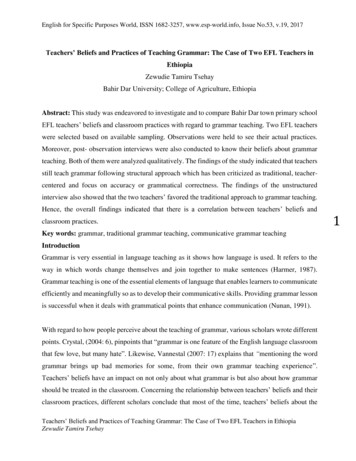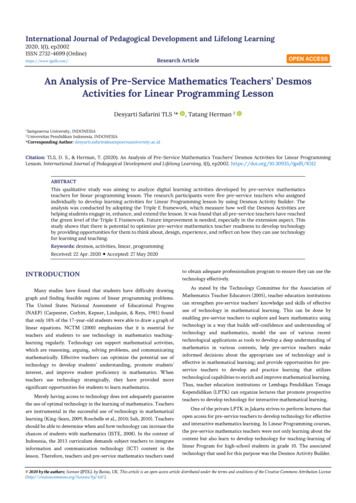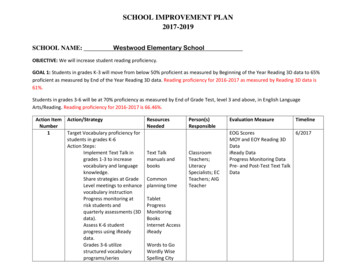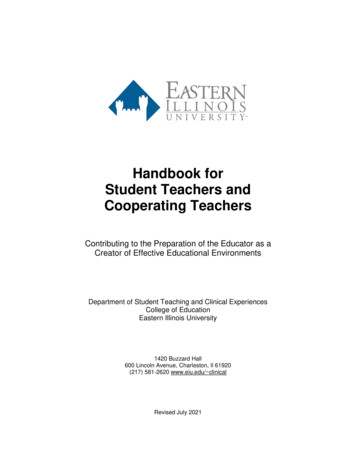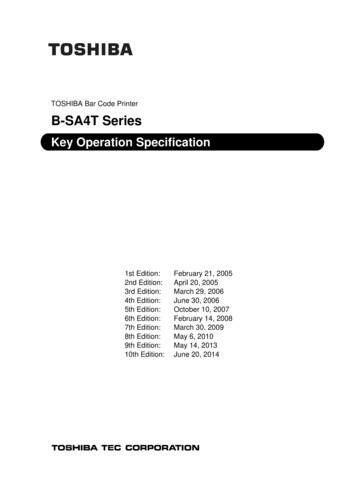
Transcription
Glenmore Cricket ClubCRICKET COACHING MANUALTeachers Edition 2016
Skills FocusBASIC BATTINGBatting Batting stancePick up the bat by first cocking at the wristsBatting grip V’s formed by thumb and forefinger aligneddown front of batHands together in middle of handle Side onFeet shoulder width apartHead upright, eyes levelBASIC BOWLINGGripBowling with a run up Grip the ball with thumb underneath and first twofingers on topBowl the ball with seam upright pointing towardthe batterWhen at the bowling crease beginners should be: Side on to the targetNon-bowling hand reaches up high and bowlinghand moves down lowNon-bowling hand pulls straight down as bowlinghand moves over the top (arm straight) to bowlFollow through with bowling hand across thebody To teach bowling with a run-up only progress tonext point when the previous skill is masteredRevise: basic bowling action (arm action, includingrelease of the ball)LIFT front knee and at the same time, perform theinitial stretching movement of the arms. STAMPon front foot in a straight line towards the targetand BOWLSTEP THROUGH with back foot towards the targetby taking it across the front foot. LIFT front foot,STAMP and BOWLThen, build run-up one step at a time. That is, oneSTEP back foot STEP THROUGH across front foot,LIFT front foot, STAMP and BOWLFIELDING THROWING & CATCHINGGround Fielding Stay front on to the ballBend knees and move into a low positionThrowing Body side on to targetStep towards targetThrowing hand moves back and up fingers on topof ballNon-throwing hand points toward the targetThrow the ball keeping the elbow highThrowing arm follows through across the bodyCatching Move into position quicklyKeep head still, eyes on ballFingers point down, up or to sideGiving with the ballUnderarm throwing Extend throwing hand back with arm straightStep towards targetSwing arm through, release the ball and allowpalm to continue through towards the targetHave body weight moving towards target
ActivitiesUse these structured and progressive schemes of work as a guideline to plan a unit of striking and fielding withinthe overall curriculum games requirement for that key stage.Each lesson includes a suggested warm up, main activity and a game. It is assumed that the lesson is 45-60 minuteslong.Warm UpFun Physical ActivitiesRunning & Stopping the BallRed RoverJogging with Imaginary FieldingStretchingLocomotion RelaysRunning with the BatSnowball TagUnder and OverRunning, Throwing & CatchingBall Handling Routine 10 Game' Catchers v RunnersCreating Space & CatchingBatting RelaysFieldingLow CatchThrowingFielding RacesShoulder High CatchTarget ThrowingHigh CatchRoll-a-BallPicking up One Handed &ThrowingStopping the Ball with TwoHandsTower GameChasing & ThrowingRun OutWicketkeepingThe Basics of BattingBlocking the BallStepping Back to Strike the BallHow to Choose Which Shot toPlayLeaning Forward to Strike theBallTarget BattingUnderarm BowlingBowling with a Run-UpTarget BowlingBowling Overarm from StandingSpinning the BallBowl OutContinuous CricketConveyor Belt CricketFielding SoccerRacing CricketMatch CricketRapid FireCaterpillar CricketPairs CricketBattingBowlingTeam Games
ActivitiesEssentialsBall Handling RoutineBasic Catching Batting RelaysContinuous CricketFielding Soccer Locomotion RelaysPairs CricketRapid FireRed RoverSnowball TagTarget BattingTarget BowlingTarget HittingTarget ThrowingUnder and Over Game SenseGet Batter OutMake Hitting Ball DifficultDefenceAvoid Getting OutPlacement and DistanceScore RunsAttackStopping The BallCatchingFieldingThrowingBowl with Run UpBowl AccuratelyHit Ball Along GroundBowlingProtect StumpsRunning Between WicketsCross Bat ShotsStraight Bat lar EnduranceTrappingStoppingCatchingHittingUnderarm ThrowOverarm ThrowSkippingReceivingStop Run ScoringCricket DodgingStoppingFallingReady PositionBalanceActivityTravellingBowl with Straight ArmFundamentalsBody Awareness
5 Lesson Plan SessionWarm UpMain ActivityMain ActivityGame1Snowball TagStopping the Ball with 2 HandsTarget BattingRapid Fire2Batting RelaysTarget BowlingTarget BattingContinuous Cricket3Locomotion RelayTarget ThrowingFielding SoccerCaterpillar Cricket4Snowball TagTarget BattingTarget BowlingConveyor Belt Cricket5Under and OverRapid FireFielding SoccerPairs Cricket10 Lesson Plan SessionWarm UpMain ActivityMain ActivityGame1Fun Physical ActivitiesLow catchThe Basics of BattingContinuous Cricket2Snowball TagUnderarm BowlingShoulder High CatchRoll a BallBatting RelayBlocking the BallBowling Overarm fromStandingRapid FireRunning & Stopping The BallHigh CatchLeaning Forward to Strikethe BallRacing CricketRed RoverBowl OutStopping the Ball with TwoHandsPairs CricketJogging with ImaginaryFieldingStepping Back to Strike the BallTarget BowlingCaterpillar CricketLocomotion RelaysTower GameHow to Choose WhichShot to PlayContinuous Cricket“10 Game”Bowling with a Run-UpPicking up One Handed &ThrowingConveyor Belt Cricket3456789Match Cricket10Match Cricket
15 Lesson Plan SessionWarm UpMain ActivityMain ActivityGame1Fun Physical ActivitiesLow catchTarget BattingContinuous Cricket2Snowball TagUnderarm BowlingShoulder High CatchRoll a Ball3Jogging with ImaginaryFieldingBlocking the BallBowling Overarm fromStandingTower Game4Ball Handling RoutineHigh CatchLeaning Forward to Strikethe BallRacing Cricket5Running with The BatBowling Overarm fromStandingStopping the Ball with TwoHands10 Game6Batting RelaysStepping Back to Strike the BallBowling with a Run-UpCaterpillar Cricket7Running Throwing & CatchingThrowingHow to Choose WhichShot to PlayBowl Out8Red RoverBowling with a Run-UpPicking up One Handed &ThrowingConveyor Belt Cricket9Creating Space & CatchingLeaning Forward to Strike theBallBowling with a Run-UpContinuous Cricket10Locomotion relaysChasing & ThrowingStepping Back to Strike theBallRacing Cricket11Running & Stopping The BallTarget BowlingWicket KeepingCaterpillar Cricket12“10 Game”Leaning Forward to Strike theBallTarget BowlingConveyor belt Cricket13T20 Blast Game14T20 Blast Game15T20 Blast Game
Practical TipsUSE EXISTING LINES/MARKINGS where possible (e.g. playground or running track).Distances stated are safety guidelines, but ADAPT TO DIFFERENTIATE between abilities where necessary.DIFFERENTIATE for lesser abilities by:(i)(ii)(iii)breaking skills down further,using different types and sizes of balls and equipment,altering times and turns.DEMONSTRATE WHENEVER POSSIBLE using the pictures to help you. “A picture tells a 1000 words”.SafetyThe players should always be at least 10m away from the batter.Cool DownAt the end of each lesson, COOL and CALM the players down by jogging 20 paces, striding 20 paces, walking 20paces and 20 seconds silence to “Think about the lesson”.N.B. This is also an ideal time for the children to evaluate their performance and to discuss and plan with theteacher ways that they can improve.
Useful Equipment
Warm Up
Fun Physical ActivitiesTime: 5 minsAim: To use a variety of physical activities to increase body temperatureOrganisationEquipment: 4 cones, existing linesInstructionsTeaching Points1. Children spread out along the start line. Remain balanced at all times.2. Give instructions of various ways for all to move from the start line toline A and back again. e.g. jogging, hopping and side striding (starshape). Be aware of the people around you. Move in a straight line.3. See ideas for progression for further ideas.Progression Walking/sprinting, arms can be by sides, above head or touching the ground. On all fours, either facing down hands first or facing up feet first (crab). Whilst jogging, pick knees up high in front or kick heels up behind. Pretend cricket skills, e.g. picking a ball off the ground in one or both hands, taking a catch, bowling a ball orhitting runs. Increase or decrease the distance of line A. Work in pairs, e.g. leap frog or wheelbarrow. Race other pairs.Suggestions for discussion on health educationTASKPut your hand on your forehead. What do you feel?Q Why do we sweat?A When you exercise, your body temperature rises. Moisture comes through the skin surface to cool you down.Q How can you replace the liquid in your body lost due to sweating?Warm Up ActivitiesA By drinking cold water.
SNOWBALL TAGTime: 5 minsAim: To use a variety of physical activities to increase body temperatureOrganisationEquipment: One ball per member of the groupInstructionsTeaching Points1. Mark out a square approximately 10m x 10mNumber of Players2. Place balls together at edge of square Group activity3. One player begins with a ball and is the taggerArea size4. The tagger attempts to catch other players by taggingthem with the ball or hitting below the shoulders with anunderarm throw 10m X 10m square or larger with abigger group5. All caught players collect a ball and become taggers6. Last player caught winsProgression Restrict/increase playing area Impose time limitsWarm Up Activities
BALL HANDLING ROUTINETime: 5 minsAim: To use a variety of physical activities to increase body temperatureOrganisationInstructions1. Around head/waist/knees/ankles (several times ineach direction)7. Bounce & catch with one hand. Try non-preferredhand. Alternate hands to bounce & catch2. Figure 8 around knees.8. Dribble like a basketball. Try non-preferred hand3. “Switch” – ball between knees with 1 hand in front &the other behind. Drop the ball & switch hands tocatch (with or without bounce). Add ‘Gorilla Walk’ bytaking a step forward with each switch9. Hit the ball on an open hand to self. Try nonpreferred hand4. ‘Yo-Yo’ – hold ball in one hand out in front. Drop ball& catch before it hits the ground with hand on top ofball. Try non-preferred hand. Alternate hands to drop& catch5. ‘Circle & catch’ - hold ball in one hand out in front.Drop ball & circle hand around the ball beforecatching it again. Try non-preferred hand6. Throw ball under one leg & catch with other hand.Repeat with opposite hand & legWarm Up ActivitiesEquipment: One ball per member of the group10. Throw ball in the air to self & clap/touch ground/spinaround etc. before catching11. Stand side on, step & throw overarm to get maximumbounce. Catch ball & repeat12. Add ‘Colour Catching’ if time permits
BATTING RELAYSTime: 5 minsAim: To use a variety of physical activities to increase body temperatureOrganisationEquipment: One bat, bat & tee per group.InstructionsTeaching Points1. ‘Dribble’ the ball up & back around a tee like their playinghockey Teach technique as appropriate,otherwise ask questions to getchildren to guide their own learningabout, ‘What is the best way to do it?’2. Hit the ball to self in air and walk/run up & back around tee3. Run up and hit ball off tee to team member who repeatsthe action.Progression Restrict/increase playing area Impose time limitsWarm Up Activities
RED ROVERAim: To use a variety of physical activities to increase body temperatureOrganisationTime: 5 minsEquipment: 4 markers set up in a large squareInstructions1. Select a few kids to start in the middle of the the square,making a line. They are the catchers2. Start the rest of the children on one side of the square facingthe catchers. They are the runners3. Coordinator calls ‘All Over Red Rover’4. All the runners try to get past all the catchers to get the ‘safezone’ which is the other side of the square5. Catchers must try to tag the children as the run past6. Any runner that is tagged then becomes one of the catchers7. Coordinator continues to call out “all over Red Rover” untilthere is just one runner left that hasn’t been tagged by thecatchers. They are the winnerWarm Up Activities
LOCOMOTION RELAYSAim: To use a variety of physical activities to increase body temperatureTime: 5 minsEquipment:Marker cones at each end of spaceand across ‘halfway’ as start/finishOrganisationInstructions1. Children Line up across ‘halfway’ line in pairs facing each other – half are #1’s & half and #2’s2. Take it in turns to go Up & Back to own end using various forms of locomotion: Eg. Running, Skipping, Hopping, Jumping, Leaping, Side Stepping, Grapevine3. #1’s go first & then tag #2’s who copy what #1’s do & the n rep eat processWarm Up Activities
UNDER & OVERTime: 5 minsAim: To use a variety of physical activities to increase body temperatureEquipment: NoneOrganisationInstructions1.Pairs (numbered off #1 & #2)4.#1 returns to ‘Bridge’ position & so on2.#1 holds body in ‘Bridge’ position5.Repeat 5 times & swap roles. Perform 2-3 ‘sets’3.#2 crawls under #1, who then lowers to Push Up positionWarm Up Activities
JOGGING WITH IMAGINARY FIELDINGAim: To combine continuous movement with fielding skillsOrganisationTime: 5 minsEquipment: 4 cones, 1 whistleInstructionsTeaching Points1. Children continuously jog round a square cornered by cones. Get down and touch the floor whenpicking up the imaginary ball.2. When the teacher calls either left' or right,' the children pretendto pick up the ball in that particular hand.3. On the call of both,' the imaginary ball is picked up in two hands.4. When the whistle blows, children change direction.Progression Increase or decrease the size of the square as appropriate. Teacher calls jump' for the children to pretend to jump and catch. Teacher calls throw' for the children to pretend to throw the ball at the stumps for a run out.Suggestions for discussion on health educationTASKThink about how much air you are breathing in now, compared to before you started warming up?Q Why do we breathe faster and moredeeply during and after exercise?A To breathe in more oxygen from the air. This is then carried by the blood to feed ourmuscles as we work them harder.Q How can we increase the amount ofoxygen that our body can take in?A By playing sport and exercising regularly, we can train our lungs to take in moreoxygen.Warm Up Activities
RUNNING WITH THE BATTime: 10 minsAim: To increase knowledge of how to run with the bat by means of a relay raceOrganisationEquipment: 2 bats per team, 4 cones / existing linesInstructionsTeaching Points1. Divide into equal teams according to the number of bats, e.g. 2per team. Grip bat at the end of the handle2. First member of each team runs to line A and back again.3. As they pass the start line next member repeats and so on.4. First team to finish wins. When waiting to run, you are allowed tostand in front of the start line, as long asyour bat is touching the ground behindit. When approaching the lines, reach outusing the full length of the bat to touchdown over the line.Progression Teams run through twice before finishing. Give a time limit (i.e. 2 minutes) teams count how many runs they can complete in the given time.Suggestions for discussion on health educationTASKRun 20 metres as quickly as possible.Q At the beginning of your run whichmuscles worked the hardest?A Your leg muscles.Q How can you improve your speed?A By strengthening your muscles. You can do this by exercising regularly.Warm Up Activities
RUNNING, THROWING & CATCHINGTime: 10 minsAim: To improve fielding skills by means of a relay raceOrganisationEquipment:4 tennis/soft balls, 4 stumps, chalkedcircles, 2 cones / existing linesInstructionsTeaching Points1. Split class into 4 equal teams. Place the ball so that it remains in thecircle.2. First person in each team starts with a ball and runs placing it in thecircle and continues forward round the skittle.3. On the way back they stop, pick up the ball and gently throwunderarm for next person to catch. Stay low when you throw the ball so thatit arrives at waist height.4. Catcher repeats.5. First team to finish wins.Progression Increase distances apart.If distance allows encourage an overarm throw.Using the same lesson format, set a time limit (i.e. 3 mins), teams count the number of clean catchesachieved.Suggestions for discussion on health educationTASKFeel the warmth on your arms and legs They will feel warmer due to exercise.Q Why do sports people warm up?A (i) To avoid injury.(ii) To get their body ready for further exercise.(iii) To feed their muscles with more blood which carries oxygen.(iv) To get themselves ready mentally as well as physically for exercise.Warm Up Activities
CREATING SPACE & CATCHINGTime: 10 minsAim: To improve spatial awareness and catching skillsOrganisationEquipment:1 tennis/soft ball per pair, 4 cones,1 whistle.InstructionsTeaching Points1. In pairs, jog around the available space changing directionfrequently. When jogging change direction to findspace.2. When the whistle blows, pairs begin low catching for 30seconds, counting their score. When catching;I.Stand 2m away from your partner.3. When the whistle blows again, pairs resume jogging.II.Catch the ball in two hands.4. Repeat process 3 4 times, with pairs attempting to beat theirprevious score each time.III.Watch the ball into your hands.Progression When jogging around, one of the pair takes the lead and must dodge, weave and side step to losetheir partner. Use the same lesson format but for the different catches on pages 21 and 23.Suggestions for discussion on health educationTASKThink about the amount of energy you have just used whilst warming up.Q How will you replace this used energy?Q Are some foods better for you than others?Warm Up ActivitiesA By eating and drinking at your next meal time.A Yes, but it is important to have a balanced diet including fresh fruit and vegetables.
RUNNING & STOPPING THE BALLTime: 5 minsAim: To increase the heart rate, using continuous movement and incorporating a fielding skillOrganisationEquipment:Minimum 10 tennis/soft balls,4 cones, 1 bucket/boxInstructionsTeaching Points1. Children in a straight line between cones 1 & 4. Run fast to get close to the ball.2. Teacher continuously rolls out balls to be stopped with handsbetween cones 1 & 2. Use two hands to stop the ball. Place the ball in the bucket/box.3. Children individually stop and collect a ball and continueround the square.4. Place the ball in the bucket/box and join the back of the line.Repeat.Progression Roll the ball out slower to make it easier, or faster to make it more difficult. Change the size of the square to increase or decrease the distance that has to be run. Loop the ball in the air for the children to take a high catchSuggestions for discussion on health educationTASKFeel your heart. is it beating faster than when you started?Q Why? What does your heart do?A When you are active, your muscles need more blood, so your heart has to work harderto pump it around your body.Warm Up Activities
STRETCHINGTime: 10 minsAim: To encourage safe stretching exercises to increase flexibility and to avoid injuryOrganisationEquipment: NilInstructionsTeaching Points1. Class jog around gently for 2 minutes, then spread out and find aspace facing the teacher. Stretching Exercises Neck: Look overright shoulder, hold. Look over leftshoulder, hold. Sides: Feet shoulder widthapart, right arm stretched above head,push up and hold. Repeat left arm.2. Work on muscles and joints from head to toe. See the teaching pointsfor different instructions.3. When stretching, hold for 10 seconds, then slowly release. Nobouncing'.4. When mobilising, rotate the joint slowly three times. Mobilising Exercises Arms: Arms abovehead, rotate forwards (3 times slowly), thenbackwards. Legs: Lift up right knee, rotateto the side then down to the floor. Repeatleft knee. Ankles & Wrists: In turn rotateclockwise and anti-clockwise.ProgressionFurther stretching exercises. (i) Arms above head palms touching, push hard against each other. (Upper body). (ii) Left foot in front of the other, bend left leg at the knee and straighten right leg, keeping the heel on the floor.Repeat, right leg in front. (Calves). (iii) Left foot forward one pace, bend right knee, keep left one straight and push back slightly. Repeat, right leg infront. (Hamstrings).Suggestions for discussion on health educationTASKClench your fist and bring your fist towards your shoulder.Q Why are your muscles so important and whatdo they do?A They hold the bones together (stability) and they produce movement.Q When you bent your arm at the elbow, what happened to the muscle tomake your arm bend?Warm Up ActivitiesA It shortened (contracted).
“10 GAME” CATCHERS V RUNNERSAim:Time: 10 minsTo practice catching and running between the wickets in acompetitive game.OrganisationEquipment: 1 tennis/soft ball, 2 bats 4 cones/existing creasesInstructionsRules1.Split into 2 teams.Catchers:2.Running team in a straight line, catchers in a circle.(As diagram). Hands together, catch in twohands.Catchers:3.Throw the ball to each player clockwise around thecircle.4.Each clean catch counts as one point.Runners: Run fast in a straight line. Reach out and touch the batdown over the line at each end.Batters:5.In turn, runners run to the batting line (crease) andback, as in a relay.6.Rules:7.When all the batters have run once, the catchersstop. Record the catchers' score.8.Teams change over.9.The team with the most catches wins.Warm Up Activities
Fielding
TARGET THROWINGTime: 10 minsAim: Throw the ball accurately hitting a targetOrganisationEquipment: 1 tennis/soft ball per pairInstructionsTeaching Points1. Throwing overarm at a marker Feet, shoulder width apart.2. 5 year olds are 5 steps back from the marker, 6 year olds are Bend your knees and keep your bottomhigh.3. 6 steps back from the marker etc4. Partner is on the opposite side, also throwing at the marker. Watch the ball into your hands.5. 1 point for hitting the cone6. 10 points for getting the marker to do the Super FlipProgression Increase distance between partners Twenty throws with right hand Twenty throws with left handFielding
LOW CATCHTime: 15 minsAim: To catch a ball between waist and ankle heightOrganisationEquipment: 1 tennis/soft ball per pairInstructionsTeaching Points1. Pairs gently underarm the ball for each other to catch. Feet, shoulder width apart.2. Serve with one hand, catch in two. Bend your knees and keep your bottomhigh.3. The ball should arrive between waist and ankle height. Watch the ball into your hands.ProgressionFirst pair to achieve 10 clean catches win. (i) Count how many clean catches can be achieved in 30 seconds. (ii) Another 30 seconds. . . Pairs attempt to beat their previous total. 5-4-3-2-1- STOP'Fielding After 5 clean catches, pairs put the ball down and switch places with their partner. Then, 4 clean catches put theball down and switch places, then 3, 2 and 1. First pair sitting down having finished win. Introduce a harder ball where safe and appropriate.
SHOULDER HIGH CATCHTime: 15 minsAim: To catch a ball at shoulder/head heightOrganisationEquipment: 1 tennis/soft ball per pairInstructionsTeaching Points1. Pairs gently underarm the ball for each other to catch. Hands up, palms facing forwards.2. Ball should arrive at shoulder/head height. Thumbs crossed, fingers pointing up. Catch, letting hands go with the ball overone shoulder.ProgressionFirst pair to achieve 10 clean catches win. (i) Count how many clean catches can be achieved in 30 seconds. (ii) Another 30 seconds. . . Pairs attempt to beat their previous total. 5-4-3-2-1- STOP' After 5 clean catches, pairs put the ball down and switch places with their partner. Then, 4 clean catches put theball down and switch places, then 3, 2 and 1. First pair sitting down having finished win. Introduce a harder ball where safe and appropriate.Fielding
HIGH CATCHTime: 15 minsAim: To catch a ball dropping from above head heightOrganisationEquipment: 1 tennis/soft ball per pairInstructionsTeaching Points1. Pairs loop the ball underarm for each other to catch. Watching the ball all the time, move towhere it is dropping.2. Try to make the ball drop near partner's head. Cup hands together, little fingerstouching. Hands up early, palms facing upwards Catch at eye level, then relax arms.Progression Increase/decrease the height of catches. Before catching the ball:(i) Clap once, twice, etc.(ii) Perform a skill, e.g. call your name or touch the ground with 2 hands, etc.Fielding Make the catcher move by looping the ball slightly to the right or left. Introduce a harder ball where safe and appropriate.
STOPPING THE BALL WITH TWO HANDSTime: 15 minsAim: To stop a fast moving ball using two hands and the body as a barrierOrganisationEquipment: 1 tennis/soft ball per pairInstructionsTeaching Points1. Pairs roll the ball in a straight line for partner to stopusing two hands. Stand side on, so the arm you rollthe ball with is furthest from yourpartner.2. Having stopped the ball, they stand up and roll the ballback for partner to repeat.3. The ball must be rolled underarm, not bounced alongthe ground. As the ball approaches get downon the knee nearest your partner. Stop the ball alongside your knee,with hands together and fingerspointing down.Progression Children should move into the line of the rolling ball before going down on their knee. Topractice this, pairs roll the ball very slightly to the left or right of their partner. Stopping the ball and then throwing to partner:(i) One of the pair rolls the ball out, the other stops the ball using 2 hands and body as abarrier, then quickly stands up and throws gently overarm one bounce to partner. Repeat 3times each, then change.(ii) If space is available, allow for a harder throw by increasing the distance apart.(iii) Throw to partner without bouncing, (i.e. for partner to catch). Pairs roll the ball faster to test if their partner can stop it cleanly.Fielding
PICKING UP ONE HANDED & THROWINGAim: To pick up and throw a ball underarm on the runOrganisationTime: 15 minsEquipment: 1 tennis/soft ball per pair, 6 cones / existing linesInstructionsTeaching Points1. Pairs stand opposite each other. Shape throwing hand like a scooper'.2. Person on the start line has the ball and runs outplacing it on the middle line and then returns quickly tothe start line.3. Now, person on the fielding line runs towards the balland picks it up one handed, then throws it underarm forperson on the start line to catch. Pick the ball up by the outside ofyour foot. Staying low, throw the ballunderarm keeping your head stilland arm straight.4. While fielder runs back to fielding line, person on startline repeats for next turn.5. Change after 3 turns each.ProgressionFielding Set a time limit, (i.e. 2 minutes). 1 point is scored for each successful pick up and throw. Thepoint only counts if the ball is caught. Highest pair score wins. Person on start line gently rolls the ball out for fielder to run, pick up and throw the moving' ball back to the person on the start line. Person on the start line rolls again onlywhen the fielder has returned to fielding line. First pair to have 3 successful turns each win.
THROWINGTime: 15 minsAim: To throw a ball overarm with power and accuracyOrganisationEquipment: 1 tennis/soft ball per pairInstructionsTeaching Points1. Pairs throw the ball powerfully overarm onebounce to each other. Point non-throwing arm atpartner.2. The ball should be bounced so that it arrives atwaist height. Lift your throwing arm up andbend it at the elbow. Rock back then forward,releasing the ball quickly to yourpartner. Keep your eyes fixed on thetarget.Progression Increase distance apart. Use a hoop 2m in front of partner as a target. 5 attempts each. 1 point for eachsuccessful one bounce attempt. Highest pair score wins. Throw the ball directly for partner to catch without bouncing.Fielding
CHASING & THROWINGTime: 15 minsAim: To chase and return a ballOrganisationEquipment: 1 tennis/soft ball per pair, 6 cones / existing linesInstructionsTeaching Points1. Pairs stand beside each other on the start line. Chase and catch up with theball.2. One of the pair gently rolls the ball out straight forpartner to chase and pick up between the middleand end line.3. Chaser throws the ball overarm one bounce backto partner.4. When chaser returns, repeat. Let the ball roll into yourthrowing hand, by the outside ofyour foot. To turn, spin on the balls of yourfeet towards partner. Balance and throw.5. Change after 3 turns each.ProgressionFielding Chaser throws the ball to partner without bouncing, i.e. partner catches. Increase distance of throw by moving middle and end line further from start line. Set a time limit (i.e. 2 minutes). 1 point is scored for each successful chase and return.The point only counts if the ball is picked up between the middle and end line.Change after each turn. Highest pair score wins. Repeat with pairs attempting to beat their previous score in the set time.
WICKETKEEPINGTime: 15 minsAim: To catch a bouncing ball, from a crouched positionOrganisationEquipment: 1 tennis/soft ball per pairInstructionsTeaching Points1. Pairs throw the ball overarm one bounce to each other. Hands together, fingers touching theground.2. Stand when throwing. When receiving, crouch and risecatching the ball with two hands. Weight on balls of your feet. Rise with the bounce of the ball. Catch with two hands at waist height.Progression Vary the throw slightly to the partner's left or right. Set a time limit, (i.e. 1 minute). Pairs must stand when throwing and crouch when receiving. Thepair with the highest number of successful one bounce attempts win. Increase the distance and speed that the ball is thrown.(i) Introduce wickets/skittles/chairs in front of one of the pair (wicketkeeper). Partner deliberatelythrows to miss the wicket. The wicke
CRICKET COACHING MANUAL Teachers Edition 2016. Skills Focus BASIC BATTING Batting Pick up the bat by first cocking at the wrists . When at the bowling crease beginners should be: Side on to the target Non-bow
